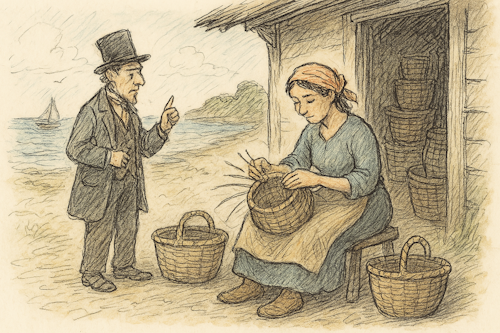The Basket Weaver
Illustrates Discipline, Systems Thinking, Flow, Respect for Craft
Modern Agile teams often seek speed. But some lessons come only through patient refinement. The Basket Weaver is a parable about deep craftsmanship, purposeful constraint, and how mastery emerges not from scale but from care.
This story helps teams reframe their definition of productivity. It invites leaders and Agile coaches to explore the tension between throughput and quality, and to ask a different question: not "How much are we producing?" but "How well are we practicing?"
Once in a coastal village, lived a weaver named Sen. Her baskets were known far beyond her region. Not for their size or number, but for how they felt in hand. Smooth. Balanced. Whole.
One day, a merchant visited her workshop. "You could earn much more," he said, "if you hired more people, made more baskets, and used machines. Mass produce them. You would be rich."

Sen smiled. "But I do not weave to become rich."
"You could be faster," he insisted.
"Perhaps," she replied. "But I would not be better."
Curious, the merchant watched her work. She prepared each reed with water and ash. She wove slowly, deliberately, pausing after each layer to feel its shape. She adjusted. Then continued. There were no discarded baskets, only ones that grew with attention.
Later, an apprentice asked, “Why don't we copy other designs? Or rush to finish more?”
Sen said, “A basket carries more than things. It carries the care of its making. Rush, and it unravels.”
Years passed. Other weavers came and went. Their names faded. Sen's baskets remained, passed from hand to hand, still whole.
Lessons Learned
Respect for Process is Respect for People
Sen did not chase volume. She honored rhythm. Agile teams often face pressure to produce more, faster. But when pace outstrips purpose, quality suffers. Sustainable delivery is born from mindful, humane systems.
Craft Grows Through Attention
Each basket reflected Sen's intimate knowledge of her materials and her own limits. Similarly, great teams do not stumble into mastery. They pause, reflect, and improve with intention. They treat retrospectives, pairing, and refinement as serious acts of care.
Slowness is Not Waste
To outsiders, Sen's pace looked inefficient. But waste is not in time spent, it is in value lost. Agile teams should look beyond velocity charts. Are we solving the right problems? Are we building with integrity? Is our work holding together under stress?
Small Is Scalable When It Is Repeatable
Sen did not scale by adding hands. She scaled by deepening her skill and teaching others through example. Agile transformation grows not through directives, but by modeling excellence, sharing it, and letting it spread organically.
Constraints Invite Creativity
Sen used what the land offered. She did not wish for gold or plastic. Within limits, she found freedom. Agile teams thrive when they embrace constraints and let them guide creative problem-solving instead of resisting them.
Coaching Tips
- Use this Parable to Anchor Conversations around Definition of Done: Are we finishing baskets that last, or just completing tasks that look finished?
- Help teams rethink Performance Metrics: Replace productivity talk with craft talk. Invite them to describe what “care” looks like in their process.
- Foster Psychological Safety: Help teams explore what would make it safe enough to “bell the cat.” This opens the door to healthy conflict, experimentation, and courage.
- Explore Technical Debt Conversations: The cost of weaving poorly does not always show up right away. Help leaders understand why “done” is not the end.
- Normalize Discipline as Joy: Teams often equate discipline with control. But Sen's story shows discipline as devotion. What might that look like in code, in design, in review?
Sen's legacy was not her output, but her practice. The baskets she made endured because she did not rush their birth. Agile teams, too, leave a legacy. Not in how many features they push, but in how well their systems hold over time.
The Basket Weaver reminds us: Agility is not a race. It is a rhythm.
It is not about how many baskets we build. It is about whether they are worth carrying.


